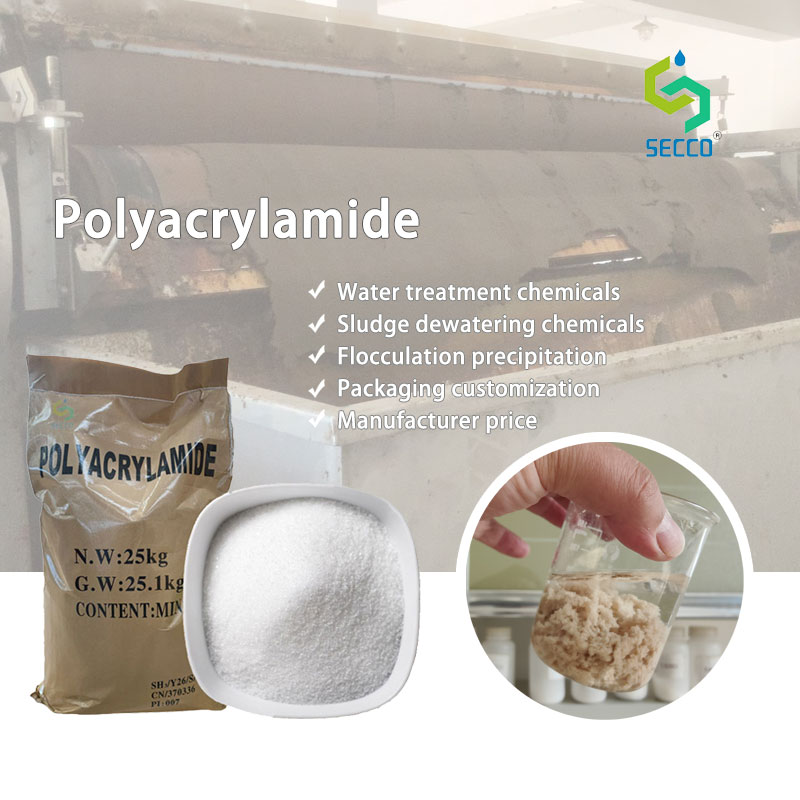Polyacrylamide (PAM) plays a critical role in sludge dewatering, and its selection must be based on sludge characteristics, dewatering equipment, and process conditions. Below is a detailed analysis of the selection principles and performance optimization.

I. Selection Principles
1. Sludge Characteristics Analysis
Organic Content: Highly organic sludge (e.g., municipal sludge) is typically negatively charged and requires cationic PAM (CPAM). Inorganic-rich sludge (e.g., industrial sludge) may use anionic (APAM) or non-ionic PAM (NPAM).
Sludge Source:
Municipal Sludge: High organic content, hydrophilic—requires high-charge-density CPAM.
Industrial Sludge (e.g., electroplating, papermaking): May contain heavy metals or inorganics—lab testing is needed.
pH Value:
Acidic (pH < 7): Prefer non-ionic or low-charge CPAM.
Alkaline (pH > 7): High-charge CPAM or APAM may be suitable.
2. Ionic Type Selection
Cationic PAM (CPAM): Neutralizes negative charges on sludge colloids, compresses the double layer, and bridges flocs (used in ~90% of municipal sludge dewatering).
Anionic PAM (APAM): Forms long-chain bridges, suitable for inorganic sludge or combined with metal salts (e.g., PAC).
Non-ionic PAM (NPAM): Used in neutral/weakly acidic sludge but less common.
3. Molecular Weight (MW) & Charge Density
Molecular Weight:
High MW (12M+ Da): Forms dense, large flocs—ideal for centrifuges & belt presses.
Low MW (6-8M Da): Better for plate-and-frame filters (avoids cloth clogging).
Charge Density:
High charge (20-40%): For highly organic, dispersed sludge.
Low charge (5-10%): For inorganic sludge or pre-conditioning.
4. Matching Dewatering Equipment
Centrifuge: Medium-high charge density, medium-high MW CPAM for fast flocculation.
Belt Filter Press: High MW, medium-high charge CPAM for shear-resistant flocs.
Plate-and-Frame Filter: Low MW, low charge CPAM/APAM to prevent clogging.
5. Solubility & Preparation
Dissolution: 0.1-0.3% concentration, water temperature ≤60°C (prevents degradation).
Mixing Speed: 50-200 rpm (avoids chain breakage).
II. Performance Evaluation Metrics
Dewatering Efficiency
Moisture Content: Optimal PAM reduces sludge from 98% to 60-75%.
Cake Thickness: Belt presses need uniform cakes; centrifuges require high solids.
Floc Properties
Size: Ideal floc diameter 1-5 mm (too large traps water; too small causes loss).
Strength: Shear resistance (critical for centrifuges).
Chemical Consumption & Cost
Typical dosage: 2-5 kg PAM per ton of dry sludge (optimized via jar tests).
Filtrate Quality
Turbidity (NTU) should be <50 to minimize recycling load.
III. Common Issues & Optimization
Filter Cloth Sticking: Caused by excessive PAM or high MW—reduce dosage or switch to low-viscosity PAM.
Weak Flocs: Increase charge density or adjust pH to 6-8.
Chemical Waste: Use gradient dosing (low charge first, then high charge).
IV. Experimental Selection Process
Lab Test (Jar Test): Screen ionic type, observe floc formation & settling.
Pilot Test: Simulate full-scale equipment, optimize MW & dosage.
Field Validation: Track dewatering rate, chemical cost & operational efficiency.
V. Case Studies
Municipal WWTP: CPAM (12M Da, 30% charge) reduces moisture from 98% to 65%, costing $5-8 per ton of dry sludge.
Textile Sludge: APAM + FeCl₃ reduces moisture to <70%.
Conclusion
Proper PAM selection significantly enhances sludge dewatering efficiency and reduces disposal costs. Field adjustments based on lab tests and equipment parameters are essential for optimal performance.
If you are interested in our products or have any questions, please fill in the form below. We will contact you immediately after receiving it. Thank you for your choice